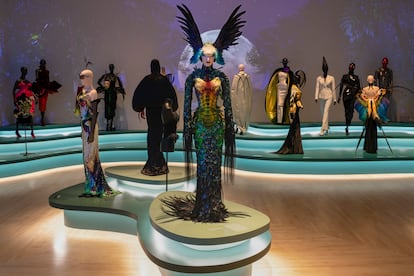New York, at the feet of Thierry Mugler
The French fashion designer’s show – titled ‘Couturissime’ – takes on legacy status on the one-year anniversary of the death of the great couturier


One year and two months after the death of the French fashioned designer Thierry Mugler (1948-2022), his exhibition, Couturissime, continues to triumph in New York City.
The retrospective, which explores the designer’s fascinating legacy, toured Montreal, Amsterdam, Munich and Paris before his death. Now, posthumously, it takes on a different meaning, like everything you appreciate when it’s over: Mugler made history.
Mugler is an icon of the transgressor. During the 1980s and 90s, the designer made history, revolutionizing the catwalks by turning what used to be the mere presentation of a clothing collection into the sensation of the season.
Thousands of people paid to see his fashion shows, which lasted more than an hour and were pure spectacle. They revolved around a theme and had a soundtrack and special guests. Mugler’s motif had an exacerbated imagination – pure play and delight – which was best manifested via stage costumes.
The unpredictable stagings that accompanied his designs made him stand out among his contemporaries. He dressed models – among them Jerry Hall, Iman, Kate Moss and Naomi Campbell – as well as celebrities, such as Lady Gaga, Beyoncé, Cardi B and Kim Kardashian. He also worked with people who had nothing to do with the world of fashion, but sought originality, including the performers in Cirque du Soleil.
Anyone who wanted to go down in history in a groundbreaking way turned to Mugler. He also directed music videos, collaborating with artists such as George Michael. His perfume – Angel – became a bestseller. He was a visionary: his designs played with the man-machine duality, long before cyborgs were normalized in society. He didn’t follow trends; he created them.
“Mugler was a pioneer in addressing diversity and female empowerment, as early as 1970,” said Thierry-Maxime Loriot, curator of the exhibition. 150 pieces are on display at the Brooklyn Museum, reflecting his career from 1977 to 2014.
Just as fascinating as his work was the personality and life of this extravagant fashion designer. He began his career at the age of 14, as a professional dancer in the ballet of the Rhine Opera, in Strasbourg. But when he died at the age of 73, he had the physique of a boxer. His radical metamorphosis began in 2003, when Mugler temporarily abandoned haute couture. He turned to bodybuilding (he had always been an amateur) and ended up bordering on vigorexia.
He underwent several cosmetic surgeries that left his face almost unrecognizable. The first operations had been done to repair damage as a result of accidents, but as Mugler himself revealed to Interview magazine, there were changes he made for fun. For example, putting a little hip bone on his chin. “I wanted my face to represent progress, because after so many years of being a slim, sweet dancer, I wanted to be a warrior. I have done so many things throughout my life... I have struggled so much... I am a superhero, so it’s normal that I have the face of one,” he said.
The exhibition – Thierry Mugler: Couturissime – is a true legacy of the designer. It can be seen at the Brooklyn Museum, which, in recent years – in an effort to reach a new audience – has hosted the work of designers such as Christian Dior, Jean-Paul Gaultier and Pierre Cardin. In recent years, museums of the stature of the MET tend to dedicate at least one of their spaces to the legacy of some of the most important designers in history. They have also, increasingly, been giving prominence to fashion as art.
Sign up for our weekly newsletter to get more English-language news coverage from EL PAÍS USA Edition
Tu suscripción se está usando en otro dispositivo
¿Quieres añadir otro usuario a tu suscripción?
Si continúas leyendo en este dispositivo, no se podrá leer en el otro.
FlechaTu suscripción se está usando en otro dispositivo y solo puedes acceder a EL PAÍS desde un dispositivo a la vez.
Si quieres compartir tu cuenta, cambia tu suscripción a la modalidad Premium, así podrás añadir otro usuario. Cada uno accederá con su propia cuenta de email, lo que os permitirá personalizar vuestra experiencia en EL PAÍS.
¿Tienes una suscripción de empresa? Accede aquí para contratar más cuentas.
En el caso de no saber quién está usando tu cuenta, te recomendamos cambiar tu contraseña aquí.
Si decides continuar compartiendo tu cuenta, este mensaje se mostrará en tu dispositivo y en el de la otra persona que está usando tu cuenta de forma indefinida, afectando a tu experiencia de lectura. Puedes consultar aquí los términos y condiciones de la suscripción digital.
More information
Archived In
Últimas noticias
Trump claims peace in Ukraine is near, but Moscow suggests otherwise
A survivor’s account of the Interoceanic Train accident: ‘We were scared because of the speed on the curve’
The Interoceanic Train, the Mexican alternative to the Panama Canal
What is known about the Interoceanic Train derailment in Oaxaca
Most viewed
- Oona Chaplin: ‘I told James Cameron that I was living in a treehouse and starting a permaculture project with a friend’
- Reinhard Genzel, Nobel laureate in physics: ‘One-minute videos will never give you the truth’
- Why the price of coffee has skyrocketed: from Brazilian plantations to specialty coffee houses
- Pablo Escobar’s hippos: A serious environmental problem, 40 years on
- Chevy Chase, the beloved comedian who was a monster off camera: ‘Not everyone hated him, just the people who’ve worked with him’










































